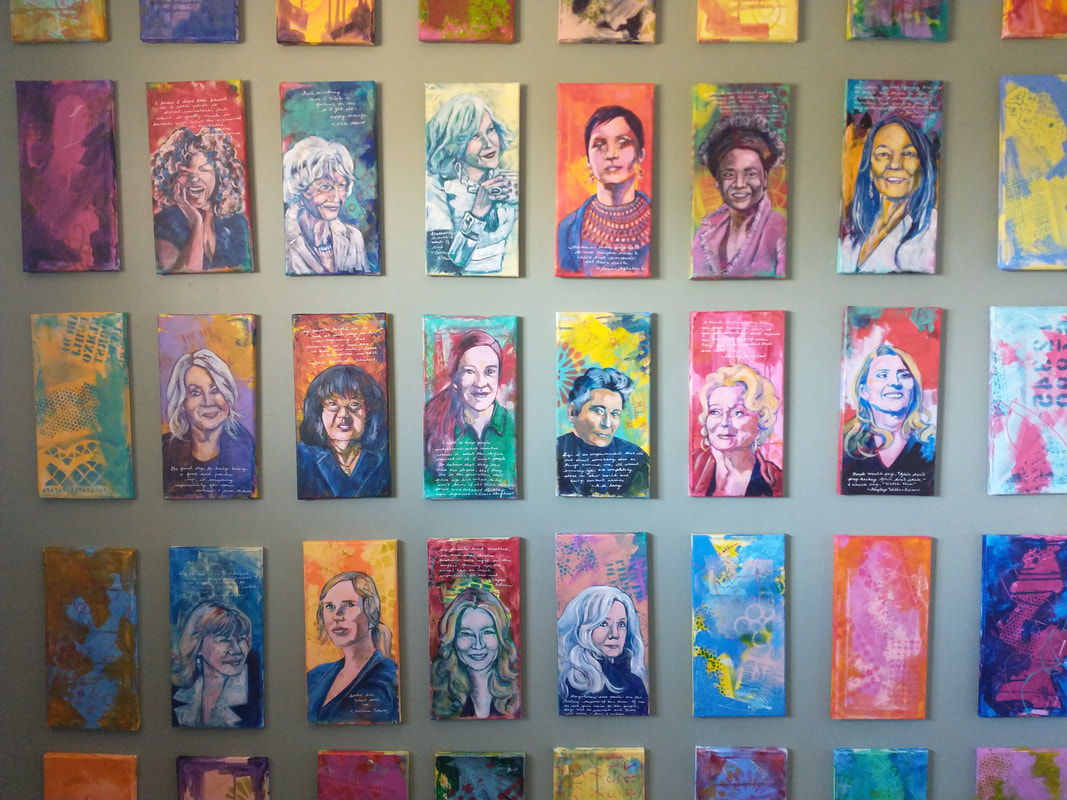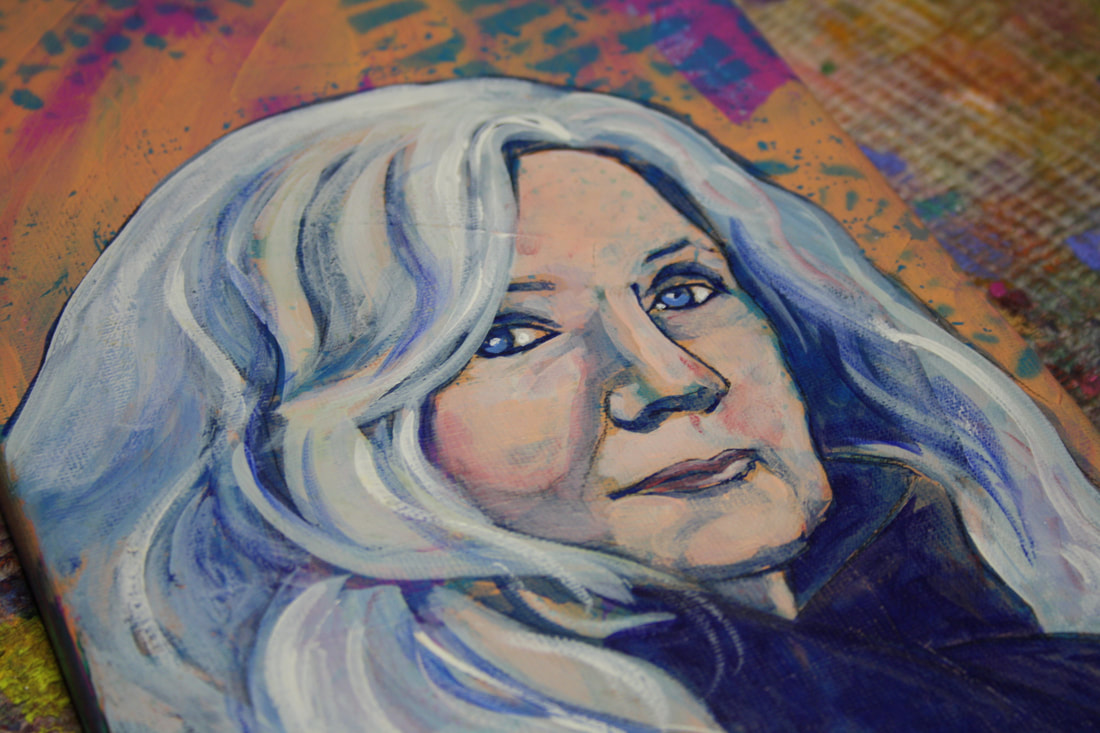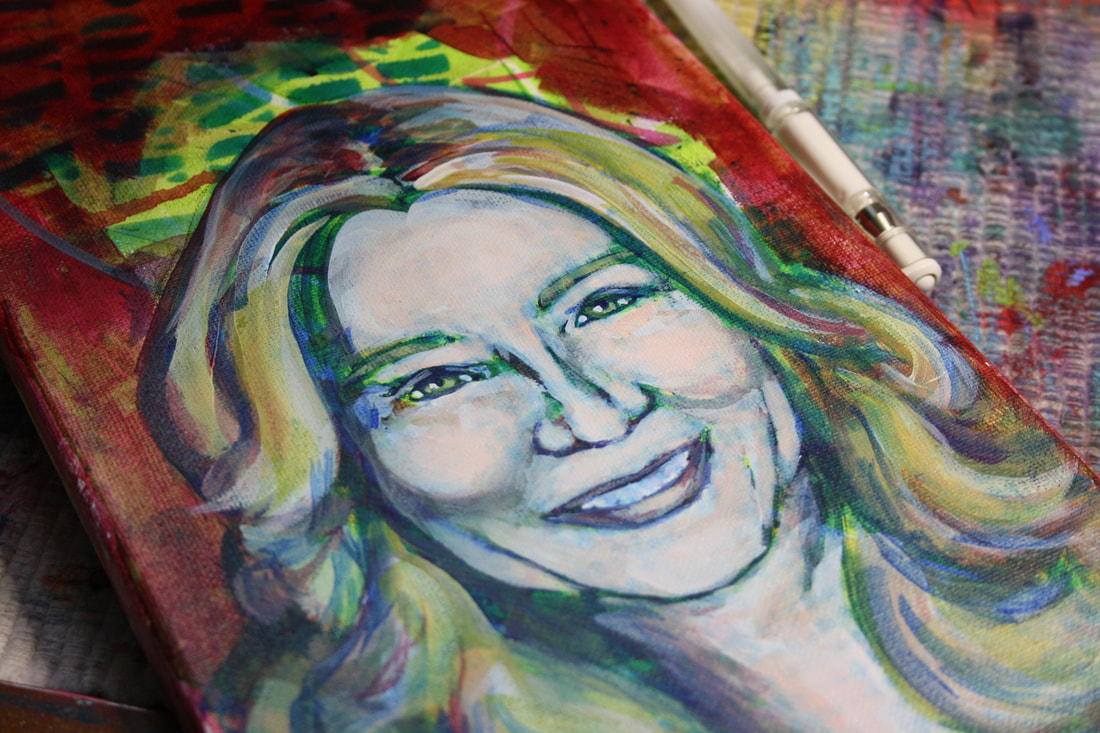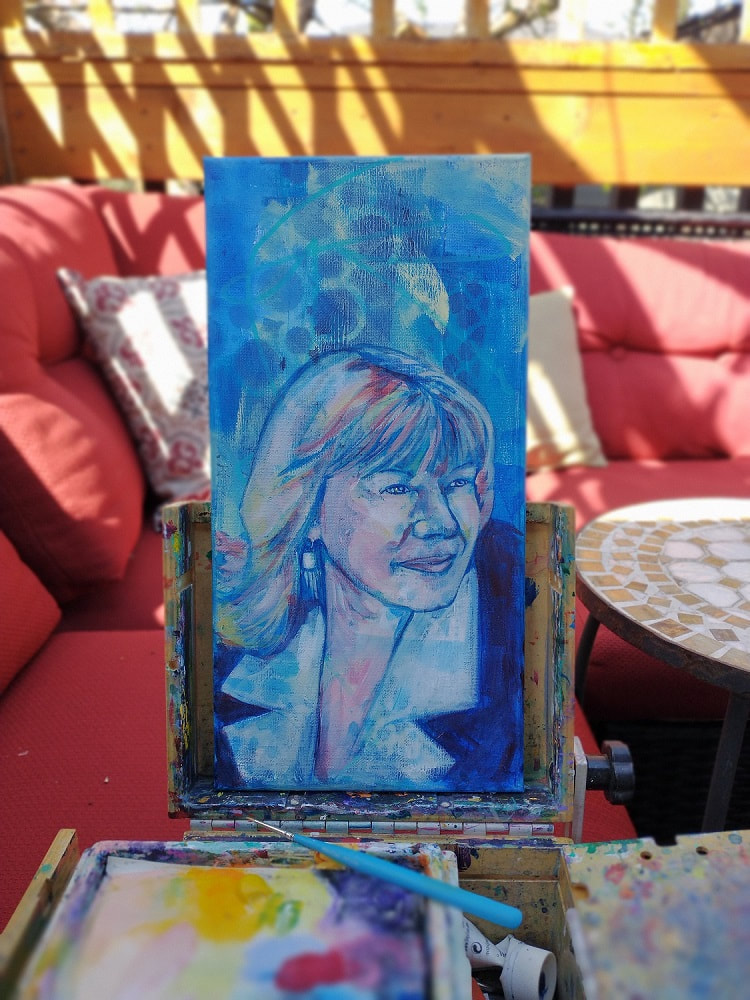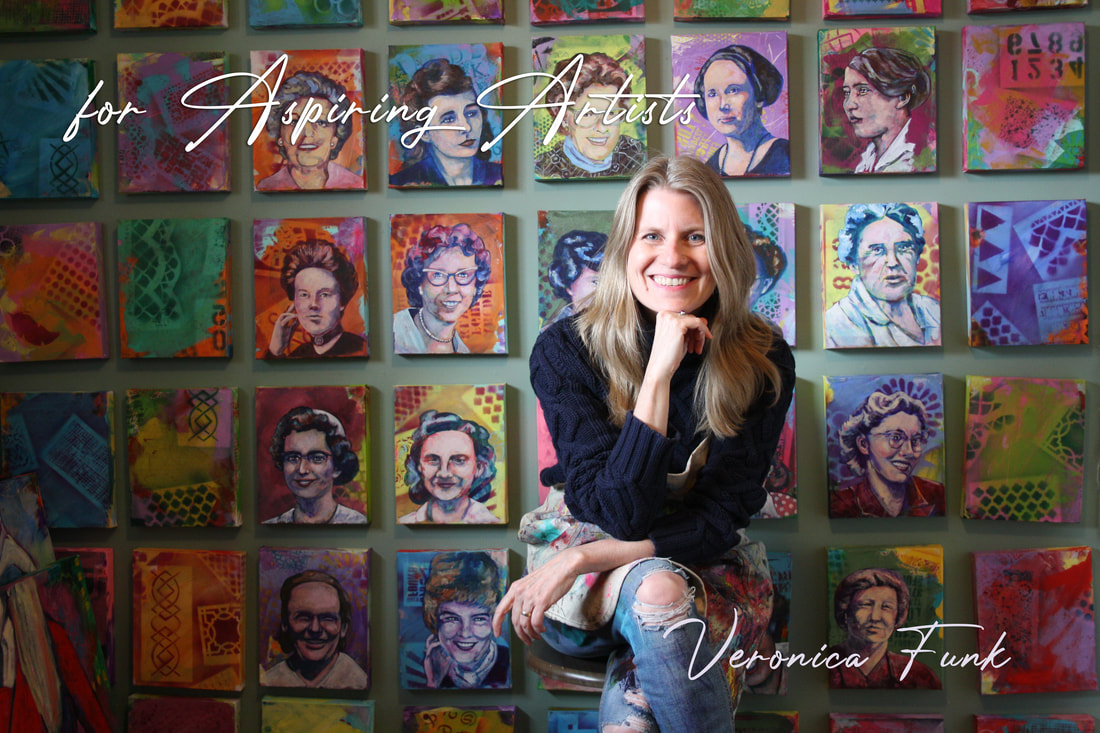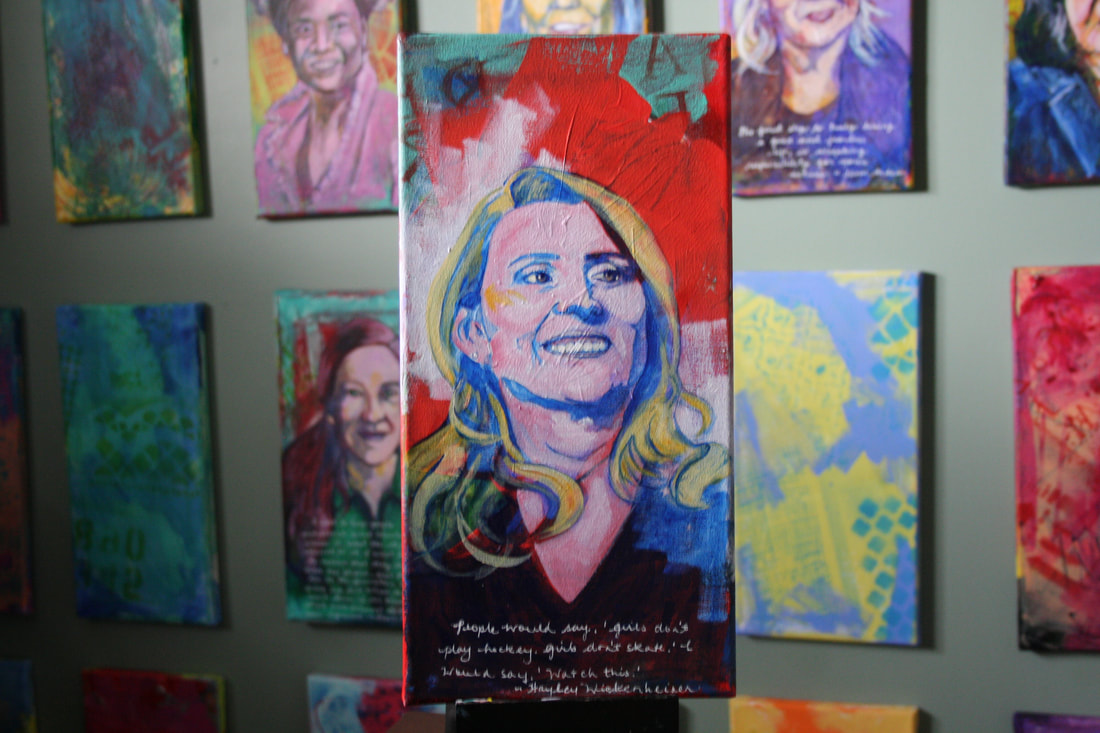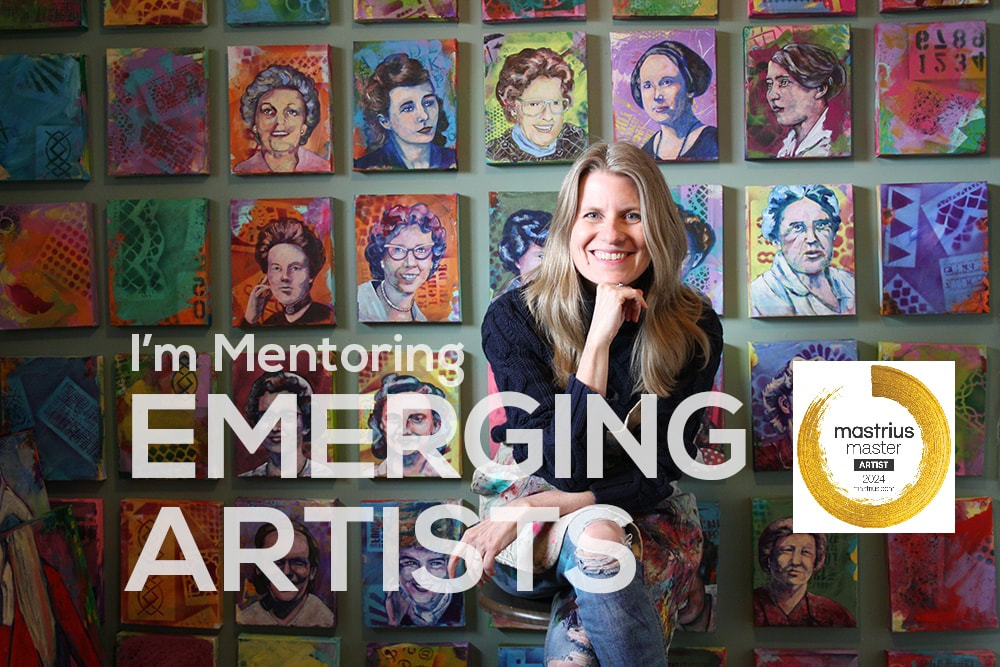I didn’t intend to be political. But somebody has to be the troublemaker Jane Ash Poitras was born in Fort Chipewyan Alberta in 1951. Her mother died of tuberculosis when Poitras was six and she was adopted by an elderly German woman. She grew up in Edmonton, Alberta in a Catholic household. Before turning to a career in the arts, she obtained a B.Sc. in microbiology at the University of Alberta. She later obtained a Bachelor of Fine Arts degree in printmaking from the University of Alberta and a Master's from Columbia University.
Internationally acclaimed Canadian artist Jane Ash Poitras says her works “are all about serendipity. Being in the right place at the wrong time. Or the wrong place at the right time, making those connections and creating a piece of art about it.” Poitras began making seemingly contradictory connections as a young adult. Following a Roman Catholic upbringing in Fort Chipewyan, Alberta, she began exploring her Cree heritage. She earned a degree in microbiology, then studied art at Columbia University where she was influenced by the work of American artists Mark Rothko, Kurt Schwitters, Robert Rauschenberg and Cy Twombly. She developed her own unique practice of layering images, text, textures and found objects into diverse narratives in her painting and printmaking. Her work continues to be deeply political, spiritual, scientific and outspoken. NGC Magazine: You said that you feel Prayer Ties My People, one of your works in the Gallery’s collection, is misnamed. Why? Jane Ash Poitras: This piece is about the little bundles of cloth that we spend hours making for a ceremony. We put the tobacco in each one, then we tie them to our Sun Dance poles for when we do our Sun Dance ceremony. Those prayers are offered up to the Great Spirit of whatever religion you are. It should be called "Prayer Ties for Everyone" because everyone needs prayer ties. Even the politicians. Who else is going to tell them what to do if not the artists? We have been influencing politicians for time immemorial. NGC Magazine: You cite the influence of artists such as Robert Rauschenberg and Cy Twombly. How did they influence your technique and practice? Jane Ash Poitras: I like Twombly’s scribbles and messages. Same with Rauschenberg. He writes on his work and he was inspired by his mother who was a seamstress. That’s why he has patchwork on his work, collaging it and patching it. These artists were transformers. They put pieces together that others said shouldn’t go together. But they said to hell with it, let’s see what comes out of this. What usually came out of it was a big statement because of their genius and their intuitiveness and intelligence. They were saying: "Wake up world. We need to talk about climate change. We need to talk about the opiate crisis." NGC Magazine: Your work reflects a powerful combination of the spiritual and the political. Jane Ash Poitras: I have done that all my life and that is how I got respect. I am fearless. I’m a law-abiding, Catholic person, but I don’t mind telling people off, the ones who deserve to be told off. But they know when they deserve it and I embrace them with love and spiritually heal them. I believe art can be spiritually healing. ~ National Gallery of Canada Registration for the Levelling Up Aspring Artist Mastermind group is now open...more information can be found online here. We work together as part of a small supportive group to hone your style and find your creative voice. Memberships are available on a monthly basis
AM I AN ASPIRING ARTIST? As an aspiring artist, you have been creating on the side, as a hobby, and now you're ready to take it to the next level. YOU'RE INTERESTED IN:
LevellingUp’s Mastermind groups are high-impact apprenticeship communities. There are a maximum of 8 Member artists in each Mastermind group, plus a Navigator facilitator, plus the Master.Your group meets with your Master Artist once monthly for a 2 hour live mentoring session using Zoom. Between monthly sessions, you get support and encouragement from your artist peers on LevellingUp’s private discussion board, LUchat. During the first hour of each monthly session the Master provides feedback on the homework you completed since your last session. The second hour of each session is spent in new teaching, with the teaching focused on what your Master feels you need to know next to progress on your artist journey. Every session ends with a homework assignment related to the teaching. Since there is no homework to review in the first session, the first hour of the first Mastermind session typically has the Master ensuring they fully understand the needs of each Member. This time is also a great opportunity for you to get to know the other artists in the group. Members tell us the safe community their group provides gives them the encouragement and support essential to venture out into new territory. The more you are in the room working, experimenting, banging away at your objective,
the more luck has a chance of biting you on the nose. ~Twyla Tharp, The Creative Habit Story-tellers and poets are the history-keepers of our time. If we do not give voice to the people, they will be silenced, and time will cease. That’s a microcosm of how Wilson processes life, whether in her long-time role as artist and prolific author of nine award-winning books, two CDs and four VideoPoems; or in her well-known role as mentor and educator. Sheri-D has always been dedicated to stirring the creative pot on many levels. Philosophically she believes “it’s not what you take, but what you give back.” That mind-set is that established the requirement for any poet to win the award given in her name by The League of Canadian Poets—The Sheri-D Wilson Golden Beret Award.
In 2003 she started and produced the popular Calgary Spoken Word Festival, which ran for 11 years and became the largest spoken word festival in North America. She was the founder and director of the Spoken Word Program at The Banff Centre (2005 – 2012). Currently, she is an MFA advisor to the UofS and she has coached the Calgary Slam team (for National Competition) for nine years. These are just some of the accomplishments that led her to win the 2015 City of Calgary Arts Award! She says her imperative to pass on the ‘word,’ comes from the deep respect she has for her own teachers. Wilson studied with the likes of Allen Ginsburg, Michael McClure, Anne Waldman, Diane di Prima, Micki Maunsell, and others. Recently when Sheri-D broke her knee, instead of feeling bummed out, she managed to transform being semi-confined into a creative opportunity. The life lesson that perpetually active Wilson learned from being forced to lie back and be (physically) inactive for a while, was that those same limits that a busted knee impose upon you can also unleash a wild mind to new flights of fancy. “Something from the outside comes into your life,” she says, “and changes it. Something intervenes. Something from the outside comes in and goes, ‘okay, you are not allowed to move right now.’ And then something comes out of it and you go wow, that’s very, very interesting. Like, I wrote a new book of poetry, and yesterday I found out U of C Press is going to publish it. And I suppose, out of this silence came music, because I also recorded a CD. It was funny, I was in a full leg cast and I guess you could say I spoke into my crutch! This isn’t physical movement,” she says. “It’s soul movement.” Wilson, a long-time practising Buddhist believes her physical limitations helped spur a new level in her creative life. Why live creatively? Maybe because it’s precisely that creative ability to take the lemons life throws at you and turn them into lemon meringue which Wilson has mastered, that needs to extend beyond the arts community. At a time when there seems to be a massive disconnect between voters and the individuals running for elected office all around the world, Wilson sees creativity as the key to bridging the gap—and happily, for Calgary, believes that our city actually possesses a few politicians who also manage to live creative lives. “Calgary has a lot of amazing artists,” she says. “A lot! I don’t know that we believe there are a lot of really interesting thinkers, philosophers, poets, and other artists who live in Calgary. And… as things change, they’re evolving… Calgary is a very beautiful city, set in a very beautiful place, which is why I choose to live here. I love the landscape. We have the foothills, the mountains, the badlands, the prairies and the sky.” ~ Stephen Hunt My parents lived, breathed, ate and slept theatre. Emotions were right on the surface. Growing up, the unreal had as much importance as the real. Q: Was it just natural to become an actor or did you want to do something else to begin with?
MF: No, I think I always wanted – whatever illusions I had about doing something else, my love and heart was always definitely in this industry. I’d come by insanity, honestly. Q: Your characters in Reign and Wynonna Earp are very different. What did you like best about playing each character? MF: I loved playing Catherine in Reign because it got to develop over a while and she was multi-faceted too. She was obviously very powerful and strong and a flawed personality which is always very fun to play. I always say Catherine was somebody who didn’t have permission to own her power because she was a female. She wasn’t born with a title and her head was literally on and off the chopping block. Her job was to breed and produce further heirs. She was fiercely loyal to her sons, but also really capable of ruling, but had to do it through other voices. I found that consequently made her someone who we could perceive as manipulative but it was because she didn’t have the right of ownership to her power. I loved playing her and in our show there was room for humour which I think was critical and we played with that. Michelle Earp is someone who is definitely fierce as well. There would be a link in the fierce department. She’s fiery and loyal and the girls will learn why and what that means. What’s really fun about Wynonna Earp is there is a lot of humour in it as well which I love. I love the comedy. Q: Now, you starred as Anne of Green Gables, so what’s it like for you to be part of a huge cultural Canadian legacy in literature and entertainment with Anne of Green Gables. There are still shows on right now like the new Anne. What’s that mean to you? MF: I feel really blessed and lucky. As a young person I got to play such a phenomenal character, first of all, just a beautifully constructed character. I got to play someone who was number one, meaning as a young female her storyline, her thoughts and feelings, her desires were the spine of the story. She wasn’t an appendage on someone else’s story. I think that was why from the moment the book was first written and created at a time where we can see, Lucy Maud Montgomery’s book was rejected a number of times by different publishers. First of all female authors were not really supported or considered which led for her to have an incredible frustration and complex character with her own issues and a richness which she poured into this character which all of a sudden gave breath and life into the fact that a young girl could have these dreams and aspirations and the right to an education and to have a voice. This was being written 100 something years ago! We’ve come so far and yet have so far to come. I think that’s why Anne still resonates so strongly for people as a voice of someone who was also considered an outsider. She was not someone who had any value. She came from no money and she was even worse in the eyes of society because she was an orphan. She was considered trash literally, that’s one of the things people call her. Yet she rises above that because of her mind, her love of language, love of learning. That’s why globally Anne, no matter where I’ve gone in the world, people have seen that and meant a lot. People first read those books and then their grandmothers, mothers, aunts and whoever else would pass them on to people. Then this show, this particular iteration we had done, came around and we were very, very true in that first 4-hour miniseries in particular to the very methodical journey of the character and what the author had done. It meant a lot to people because young women could say, ‘Oh I see me. I see someone who people think isn’t beautiful. Look at how smart I can be. I have the right to a voice’. I gave you a long answer, but that’s why it’s lasted. It’s not just about a cute girl on an island and the flowers are pretty. That’s not what Anne of Green Gables is about. Q: To that point of what you said about fierce characters, if a girl wants to become a fierce character to by imitation, what kind of guidelines should you give her as an actor? MF: I think finding one’s voice is always a lifelong journey. It’s a struggle and we want acceptance, of course we do. Sometimes actually really being true to ourselves can feel lonely, and yet that will ultimately be the thing that will be the most authentic. I think it really comes back to authenticity, and ultimately it’s hard because of this world that we live in, and for young people, I really, really feel for them because you’re being bombarded with images of things or ‘I should be there’ or ‘why don’t people like me enough, why didn’t I get invited to this, why aren’t my numbers high enough, why are you ghosting me’. All of this stuff is pressure, you know? I think we need to be okay to sit in our own skins and sit with ourselves a little bit. And sometimes that may feel lonely, but that’s actually where we’re really going to find each other, if that makes sense. ~ Britany Murphy Books are what save us. Miriam Toews grew up in the Mennonite town of Steinbach, Manitoba. She provides a detailed description of life in this isolated, conservative religious community, and its impact on her family, in Swing Low: A Life (2000).
Toews won the 2000 Alexander Kennedy Isbister Award for Non-Fiction and a second McNally Robinson Book of the Year Award for her biographical memoir, Swing Low: A Life. The life she describes here is that of her father, whose voice she adopts as she recounts his heroic struggle with bipolar disease, at a time and in a place with little understanding of mental illness. A much grimmer view of small town life emerges in Toews's 2004 A Complicated Kindness, a work precariously balanced on the intersection of comedy and tragedy. Set in the small Mennonite town of East Village - a thinly fictionalized Steinbach - the novel is narrated by 16-year-old Nomi Nickel. Reeling from the loss of her older sister and mother, Nomi and her father struggle to make sense of their past and to find a way forward into what seems to be a dark and limited future. Nomi is both astutely witty and heartbreakingly vulnerable in her bluntly honest observations of herself, her family, and her town. Toews describes the book as "a critique, essentially, of fundamentalism and that particular culture of control and punishment." With 2011's release, Irma Voth, Toews again examines Mennonite life, this time in a small community in northern Mexico. Irma, the 19-year-old protagonist, is a transitional figure: her family has relocated from the Canadian Prairies to Mexico, and Irma, though a Mennonite, is now distanced from her family because of her marriage to a local man without her parents' permission. When a film crew arrives to make a movie about the Mennonite community, Irma works for them as a cook and interpreter. The novel's examination of familiarity and estrangement, the experience of moving between worlds, and the unquenchable urge toward knowledge and experience is challenging and moving. Irma Voth emerged from experiences in Toews' own life: she was invited by Mexican director Carlos Reygadas to appear in his 2007 drama Silent Light, set in a Mennonite community in northern Mexico. ~ The Canadian Encyclopedia I've become more comfortable with who I am, I never gave myself a chance to be quiet. I really needed that. Watching Rogers in her serenity shed, how carefully she articulates her thoughts and how quiet and honest they are, it's easy to imagine the young, shy girl who grew up the eldest of four children in an upper-middle-class family in Ottawa and was drawn to the microphone as a way of hiding. A few years after her parents divorced when she was 15, Rogers attended Queen's University in Kingston, Ont., where she majored in art history. Her career goal was to work in an art gallery or museum, restoring works of art. But she started pitching in at the campus radio station and that was that.
Still her career at CBC Radio has not been on a continually upward trajectory. She began in 1980 in Ottawa working on a music program. Four years later, she moved to Toronto to host a local CBC drive-home show. Then she switched to Metro Morning. In 1986, she started with the arts program that was eventually titled The Arts Tonight. Ten years later, she was offered the chance to become deputy host of Gzowski's Morningside, once sitting in for him for 11 consecutive weeks, but when he announced his retirement, she did not get the job. It went to Michael Enright and Avril Benoît, then Benoît was dropped, and finally, Rogers took over the chair from Enright, when he decided to cut back on his schedule. But just as she got the job she had wanted for so long and that many believed she was best suited for, the CBC brass decided to revamp the Radio One programs. This Morning became Sounds Like Canada, only two hours instead of three and consisting of a number of shows within a show. Rogers sounded "like a frustrated master of ceremonies at a 12-ring circus" wrote one critic. Many believed that her medical leave was the result of her frustrations. Rogers denies those rumours. "The stories that I suffered," she says, raising her hands to put imaginary quotation marks around that last word, "were exaggerated. I wasn't unhappy. It's not fair to say I was unhappy. It was challenging because I was dealing with a new program style. We were experimenting. It just so happens that my hypertension happened at the same time. "I don't know how long a time limit you put on experimentation," she responds, when asked whether there are frustrations when her instincts as a seasoned broadcaster tell her that a format isn't working. "We tried everything all at once, and it was confusing for the listeners," she says. The newly formatted Sounds Like Canada in the fall will "build on my strengths," she explains, adding that some, but not all, of the segments will be included. Does she feel that The Current and its host, veteran journalist Anna Maria Tremonti, have diminished the importance of Sounds Like Canada? "Not at all," Rogers says. "I'm a very different kind of broadcaster." But isn't that part of what may have hurt her at the CBC, that she is perceived as soft? "I don't know who sees me as soft," she says. "What I'm interested in is the human narrative. I've always wanted to know more of the what and how, not just the why. I like to ask the questions that elicit stories." Throughout her time off, Rogers has done a lot of thinking, she explains. "I'm coming back to an encounter with my faith," she offers, when we're standing outside in the sunshine, among the wild phlox. In her early 20s, following a car accident, she became a born-again Christian while a student at Queen's. She left the small group she had joined when she began working in the media. Rogers is a deeply spiritual person, even though she is not enamoured of organized religion. This inner Shelagh Rogers is hard to draw out. It wasn't until well into the interview and we were in relaxed conversation in her shed that she seemed willing to reveal it. But it's the voice you will hear when she returns to the radio. Her brush with a potentially fatal medical condition made her re-evaluate her work and life. "At the beginning of Sounds Like Canada, I was holding myself back. My laugh was an issue, and I'd think, 'Am I laughing too long?' But that's not an issue any more. If something requires joy, what's wrong with that?" She pauses; laughs; and fixes me with her determined eyes. "I'm going by my guts, and not by a pie chart." ~ The Globe and Mail What is an Aspiring Artist? As an aspiring artist, you have been creating on the side, as a hobby, and now you're ready to take it to the next level!
YOU'RE INTERESTED IN:
Monthly memberships are available and also include free interactive panel discussions on composition, commissions & more. For more information visit LevellingUp. I'm often asked about my colour palette, and it doesn't seem to change much between the portraiture I love to focus on or any other work. I like a variety of yellows, reds, purples and blues with the odd green thrown in. Lately these are my favourites:
People would say, "Girls don't play hockey. Girls don't skate." I would say, "Watch this." Wickenheiser first started playing ice hockey on a backyard rink built by her father. In 1990 she moved with her family to Calgary and then represented Alberta at the 1991 Canada Winter Games in Charlottetown, Prince Edward Island. Participating in a tournament for teenage girls aged 17 and younger, she was not only the youngest player on her team but also the smallest (at 5-feet [1.5-metres] tall). She scored three goals in the tournament, including the game-winning goal in the championship final as Team Alberta won the gold medal. Wickenheiser was named the tournament’s most valuable player (MVP).
Four-time Olympic gold medalist Hayley Wickenheiser of Canada was around 10 years old when she first had the idea of being both a professional hockey player and a doctor. Wickenheiser, now 41, grew up in Shaunavon, Saskatchewan, a town of fewer than 2,000 people and less than 2 square miles in size. A young girl in the area had been severely injured after getting hit by a grocery delivery van. “I remember going to the hospital with all the kids in the neighborhood and just being really inspired and intrigued by the doctors and nurses that were taking care of her,” Wickenheiser said. “That’s how it all started. At that age, I had two goals: to play for the Edmonton Oilers and to go to Harvard Medical School.” After retiring in 2017 as Team Canada’s career scoring leader, Wickenheiser enrolled in medical school at the University of Calgary, then took on the role as an assistant director of player development for the Toronto Maple Leafs in 2018. She was in the midst of her clinical rotation in emergency rooms around Toronto two weeks ago, when medical students and trainees were pulled from their assignments as the number of coronavirus cases in the country reached a critical point. Wickenheiser has related her medical colleagues’ traits to her athletic peers as a way of supporting their efforts during the current crisis. “I was talking to a friend who has been an emergency physician for 20 years, and she was describing how she had to shut down communications with friends because she was getting text messages from people saying how they were so sorry for her and grieving that she had to do her job, and she didn’t feel that way at all,” Wickenheiser said. "I said, ‘This is your med Olympics. This is like the Olympics for you. Yes, you’re at risk, but you’re also really damn good at your job and smart, and you’re going to do everything you can to protect yourself and your staff.’ ” - Chicago Tribune |
|


